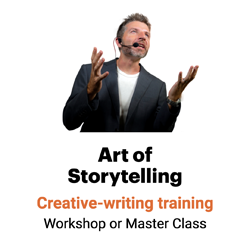Concrete details outperform abstract writing in studies
Want to change readers’ minds? Help them see your position.

That’s what two researchers at the University of Michigan did in a 1986 experiment. For the experiment, participants played the role of jurors in a trial over whether a mother, “Mrs. Johnson,” was fit to care for her 7-year-old son.
“The soul never thinks without an image.”
— Aristotle, Greek philosopher
All of participants heard 16 arguments — eight positive and eight negative — about Mrs. Johnson. But half of the subjects heard vivid examples of the arguments for her; the other half heard vivid examples of the arguments against her. For instance:
Argument against: “The child went to school with a badly scraped arm, which Mrs. Johnson had not cleaned or tended to.” Vivid addition: “The school nurse had to clean the scrape, and in the process she accidentally spilled mercurochrome and left a red stain on the breast of her nurse’s uniform.”
What a difference a detail makes. Subjects who heard the vivid arguments for Mrs. Johnson — the Darth Vader toothbrush — were 15% more likely to find her to a suitable parent (5.8 on a 10-point scale) than subjects who heard the unfavorable arguments in vivid detail (4.3 out of 10).
Tap the power of concrete language.
Why is a concrete writing style so effective?
“We tend to have a better memory for things that excite our senses or appeal to our emotions than for straight facts and dry statistics,” writes Sheena Iyengar, professor at Columbia Business School, in The Art of Choosing.
“You might overestimate the number of times your colleague wore a red tie, or underestimate how often he wore a gray one, simply because red is a brighter color.”
— Sheena Iyengar, in The Art of Choosing
“This means that you might overestimate the number of times your colleague wore a red tie, or underestimate how often he wore a gray one, simply because red is a brighter color.”
In short, “vividly presented information is more impactful than pallid information,” write the researchers, Jonathan Shedler and Melvin Manis.
So use vivid word pictures to move readers to act.
Concrete details move readers to give.
Another study shows that vivid stories are more effective at moving people to act than abstract ideas.
For the study, psychological scientists Laura Blackie and Philip Cozzolino of the University of Essex:
- Asked one-third of their subjects open-ended questions about death in general
- Told one-third a vivid scenario in which they were trapped and dying in a burning apartment (“You run to the door and reach for the handle. You pull back in pain as the intense heat of the knob scalds you violently …”)
- Had one-third think about dental pain
Then the subjects read one of two news stories: one saying that blood donations were at record lows, the other saying that they were at record highs. Finally, researchers offered subjects a pamphlet guaranteeing fast registration at a blood center and told them to take the pamphlet if they intended to give.
People who’d thought about death in the abstract were more likely to take the pamphlet if they’d read the story about the blood shortage. But those who’d visualized their own death in concrete terms were likely to take the pamphlet regardless of how badly blood was needed.
Bottom line: People who’d conjured vivid images about death were more motivated to give than those who had pondered death in the abstract.
Concrete terms outperform abstract terms.
Other research shows that concrete details work because they:
- Provide greater emotional interest and have a greater impact on judgments than bland presentations of the same information.
- Make warnings more effective. Vivid scenarios and anecdotes make warnings more effective than bland numbers do (Hendrickx, Vlek and Oppewal, 1989).
- Linger longer in the reader’s mind. In one study, vivid, emotional and interesting information helped readers decide to avoid problem drinking. That impact grew over time; the impact of bland information weakened over time (Sherer and Rogers, 1984).
To move people to act, show, don’t tell.
___
Sources: “How Thinking About Death Affects Behavior,” TS-SI.org, May 22, 2011
“People who dwell on their own mortality ‘are more likely to donate to charity,’” MailOnline, May 23, 2011
Laura E. R. Blackie and Philip J. Cozzolino, “Of Blood and Death: A Test of Dual-Existential Systems in the Context of Prosocial Intentions,” Psychological Science, July 2011
Roger Dooley, “Vivid Stories Change Donor Behavior,” Neuromarketing, Sept. 6, 2011
Chip Heath and Dan Heath, Made to Stick: Why Some Ideas Survive and Others Die, Random House, 2007, pp. 138-139
Wray Herbert, “OST Update: The Grim Reaper Revisited,” Wray’s Blog, July 21, 2011
Jonathan Shedler and Melvin Manis, “Can the Availability Heuristic Explain Vividness Effects?” Journal of Personality and Social Psychology, 1986, Vol. 51, No. 1, pp. 26-36

Leave a Reply